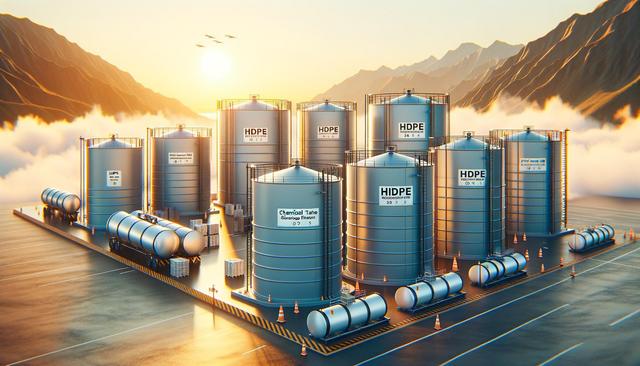
HDPE Chemical Storage Tanks: Sizes, Prices, and Industrial Applications
Understanding HDPE as a Material for Chemical Storage
High-Density Polyethylene (HDPE) is a widely used polymer in industrial storage applications due to its strong chemical resistance, durability, and lightweight nature. HDPE chemical storage tanks are specifically designed to handle a range of substances including acids, alkalis, and other corrosive chemicals. The robustness of HDPE makes it suitable for both indoor and outdoor installations, as it resists UV degradation and maintains structural integrity under varying environmental conditions. These tanks are also non-reactive, reducing the risk of contamination or chemical breakdown during storage.
Because HDPE is resistant to a wide range of chemicals, it is often selected for storing substances in sectors like manufacturing, water treatment, agriculture, and pharmaceuticals. The non-corrosive properties of HDPE minimize maintenance needs and extend the lifespan of storage systems. Additionally, HDPE tanks are typically easier to transport and install compared to heavier alternatives such as steel or fiberglass tanks.
Common Sizes and Capacities of HDPE Chemical Storage Tanks
HDPE chemical storage tanks are available in a diverse range of sizes to accommodate different industrial requirements. Capacities can range from small 50-liter containers to large tanks holding over 20,000 liters. The selection of tank size often depends on factors such as the volume of chemicals to be stored, available space, and frequency of refills. Some of the most common tank sizes include:
- 500-liter tanks for small-scale or laboratory use
- 1,000 to 5,000-liter tanks for mid-sized industrial operations
- 10,000 to 20,000-liter tanks for large-scale storage needs
In addition to standard cylindrical and vertical tank designs, HDPE tanks also come in horizontal, rectangular, and conical bottom shapes to suit specific space and flow requirements. Choosing the right size and shape contributes significantly to operational efficiency and safety.
Price Factors and Cost Considerations
The cost of HDPE chemical storage tanks varies based on size, wall thickness, design complexity, and any additional features such as fittings, level indicators, or secondary containment. In general, smaller tanks can start at a few hundred dollars, while larger, custom-designed tanks may cost several thousand. It’s also important to factor in:
- Installation costs, including base or foundation requirements
- Transportation fees, especially for larger tanks
- Optional accessories like venting systems or heating coils
While HDPE tanks may have a higher upfront cost compared to some alternatives, their long service life and minimal maintenance requirements often make them cost-effective over time. Comparing prices across trusted manufacturers can also help identify a solution that balances quality and budget.
Key Industrial Applications of HDPE Storage Tanks
HDPE chemical storage tanks are widely used across several industrial sectors due to their adaptability and resistance to a broad spectrum of chemicals. In water treatment plants, for instance, these tanks are used to store chlorine, sodium hypochlorite, and other treatment chemicals. In agriculture, HDPE tanks serve as reservoirs for fertilizers and pesticides, ensuring safe storage and distribution. Other common applications include:
- Pharmaceutical and biotech facilities for storing reagents and solvents
- Food processing plants for sanitizing agents and cleaning chemicals
- Petrochemical industries for intermediate chemical storage
The versatility of HDPE tanks allows them to be integrated into both batch and continuous processing systems. Their compatibility with various installation environments makes them a reliable choice for demanding industrial tasks.
Choosing Reliable Manufacturers and Suppliers
When selecting HDPE chemical storage tanks, partnering with a reputable supplier is essential. Trusted manufacturers often provide detailed specifications, compliance with industry standards, and warranties that ensure long-term reliability. Look for suppliers that offer customization options to match your specific operational needs, as well as technical support for installation and maintenance.
Evaluating a supplier’s reputation, customer service, and product certifications can help in making an informed choice. Many suppliers offer digital catalogs where buyers can compare tank sizes, materials, and pricing. Additionally, working with a vendor that understands local regulations and safety standards can simplify the procurement process and ensure compliance.
Features to consider when choosing a supplier include:
- Availability of after-sales support and replacement parts
- Documentation for chemical compatibility and structural design
- Flexibility in custom-built solutions for specific applications
Conclusion: Selecting the Right HDPE Tank for Your Needs
HDPE chemical storage tanks offer a practical and reliable solution for industrial chemical handling. With their wide range of sizes, excellent chemical resistance, and low maintenance requirements, they are well-suited for many demanding applications. By carefully considering factors such as size, cost, and application needs—and by choosing trusted suppliers—businesses can invest in tanks that support safe and efficient operations. Whether for agriculture, manufacturing, or water treatment, HDPE tanks remain a valuable component in industrial storage systems.


